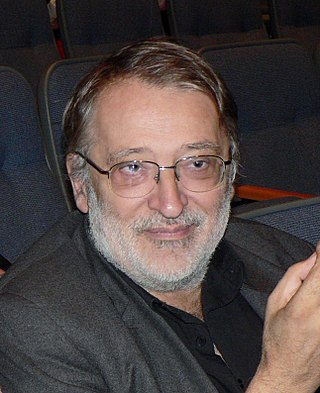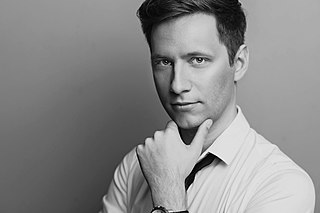
Zoltán Kocsis was a Hungarian pianist, conductor and composer.

Lajos Bárdos was a composer, conductor, music theorist, and professor of music at the Franz Liszt Academy of Music, in Budapest, Hungary, where he had previously studied under Albert Siklós and Zoltán Kodály. His younger brother, György Deák-Bárdos, was also a composer.

Zoltán Jeney was a Hungarian composer.
László Vidovszky is a Hungarian composer and pianist. During the 1970s he began composing works in a minimal style. His music has been influential on the music of György Kurtág and other modern composers.

Péter Eötvös was a Hungarian composer, conductor and academic teacher.

Leó Weiner was one of the leading Hungarian music educators of the first half of the twentieth century, and a composer.
Amadinda Percussion Group is a percussion ensemble that was formed in Budapest in 1984 by four musicians, who had just graduated from the Ferenc Liszt Academy of Music.
Zsigmond Szathmáry is a Hungarian organist, pianist, composer, and conductor.
Balázs Fülei, started to learn music at the age of eight, his first teacher was Katonáné Szabó Judit. In the Bartók Conservatory, Budapest, his professors were Gábor Eckhardt and Balázs Réti, then he made his diploma with honours at the Franz Liszt Academy of Music, Budapest, 2008 in György Nádor, Márta Gulyás and Balázs Réti's class. Balázs Fülei was an active participant in prof. Amadeus Webersinke, Florent Boffard, Ferenc Rados, Gábor Csalog, Norma Fischer, Zoltán Kocsis, Bertrand Ott, Jan Marisse Huizing, Jan Wijn, Boris Berman and György Kurtág's piano and chamber music courses. Balázs Fülei is living an active musical life as a concert pianist, he gave several concerts almost in every country in Europe, in China, Japan, Australia and in the United States. He was an artist of the International Miami Piano Festival, and the Ferruccio Busoni Festival. He won the 1st prize on the 10th Hungarian National Piano Competition, and in the Andor Földes Piano Competition of Liszt Academy of Music in 2003. He was the winner of the 43. "Arcangelo Speranza" International Piano Competition in Taranto Italy, May 2005, 3rd prize winner of the 25. International Piano Competition „Ettore Pozzoli” in Milan-Seregno in 2007. In 2007 Balázs Fülei got a special prize in the 13. International Tchaikovsky Competition in Moscow. He was selected twice to the New Masters On Tour by The International Holland Music Sessions in The Netherlands and played in 2007 in the Concertgebouw, Diligentia Den Haag and other capitals in Europe. He performed in a DVD recording in May 2006 in Tokyo, Japan with the ballades of Chopin and Liszt, then made his New York debut in Carnegie Hall, 2008. Balázs Fülei plays chamber and contemporary music many times, he played world prémieres of Hungarian composers. He is an artist of the Starlet Music Management.
Játékok is an ongoing collection of "pedagogical performance pieces" by György Kurtág. He has been writing them since 1973. Ten volumes had been published as of 2021. Volumes I, II, III, V, VI, VII, IX and X are for piano solo. Volumes IV and VIII are for piano 4-hands or two pianos.

István Láng was a Hungarian composer, academic teacher and member of the board for international music organisations. Besides freelance composing, he worked as an academic teacher of chamber music at the Franz Liszt Academy of Music, lecturing internationally in the United States and Mexico. He was secretary general of the Association of Hungarian Musicians from 1978 to 1990, and a member of the board of the International Society for Contemporary Music and the International Music Council (UNESCO).
Márta Fábián is a Hungarian cimbalom player and soloist.

György Orbán is a Romanian-born Hungarian composer.
Péter Bornemisza was a Hungarian Lutheran bishop of noble birth. His father was killed by the Turks around the time he was six years old. A scholar from England, at the University of Cracow, first interested him in Protestantism and later Philipp Melanchthon had a strong impact on him. He later preached and printed Protestant works in his native land. In addition to religious work he proved to be a significant playwright of works such as Magyar Elektra.

Stele, Op. 33, sometimes also stylised in Greek capitals as ΣΤΉΛΗ, is a composition for orchestra by Hungarian composer György Kurtág. It was completed in 1994.

Máté Bella is a Hungarian composer and university lecturer. He has received notable awards, among which are: the Junior Prima Award, the Erkel Ferenc Prize, and the Béla Bartók–Ditta Pásztory Prize.

Márta Kurtág was a Hungarian classical pianist and academic piano teacher. She was the wife of György Kurtág, with whom she performed for 60 years, including at international festivals. They often played from his collection Játékok, which they also recorded together.
István Sárközy was a Hungarian classical composer, music critic, editor and academic teacher. His compositions date from the 1940s to 1979, and include works for musical theatre, choral works and songs, orchestral and chamber works, and works for piano. Notable examples include the stage works Liliomfi (1950) and Szelistyei asszonyok, the chamber cantata Júlia énekek, the overture Az ifjúsághoz, and the Sinfonia concertante for clarinet and strings (1963). He taught at the Franz Liszt Academy of Music from 1959.
Márta Grabócz is a Franco-Hungarian musicologist, professor at the University of Strasbourg and senior member of the Institut Universitaire de France...











